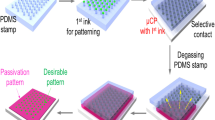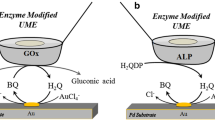Abstract
This study reports a simple but efficient method for create bacteria microarrays on a predesigned functional surface consisting of two distinctive regions; a bacterial immobilizing area and a nonimmobilizing region. The functionalized surface was fabricated by a combination of self-assembled polyelectrolyte multilayers (PEL) and micromolding in the capillaries (MIMIC) of poly(ethylene glycol)-poly(d,l-lactide) diblock copolymer (PEGPLA). The PEL region provides bacterial immobilization, and the nonspecific binding of bacteria was prevented using PEG-PLA as passivation molecules. The topological change in the functionalized surface was characterized by atomic force microscopy (AFM), which suggested the occurrence of a laterally homogeneous and well defined surface modification. An analysis of the fluorescence signals from the bacteria microarray indicates that the bacteria are viable and grow after immobilization on patterned surface features. The rapid fabrication of two different functionalities on the surface results in a uniform bacteria pattern with a high signal to noise ratio and shape flexibility, such as lines, squares, and circles. Moreover, the pattern size could be controlled from 20 to 100 μm.
Similar content being viewed by others
References
I. Barbulovic-Nad, M. Lucente, Y. Sun, M. Zhang, A. R. Wheeler, and M. Bussmann, Crit. Rev. Biotechnol., 26, 237 (2006).
C. S. Lee, S. H. Lee, Y. G. Kim, J. H. Lee, Y. K. Kim, and B. G. Kim, Biosens. Bioelectron., 22, 891 (2007).
H. Zhu and M. Snyder, Curr. Opin. Chem. Biol., 5, 40 (2001).
W. J. Lee, D. K. Choi, Y. Lee, D. N. Kim, J. W. Park, and W. G. Koh, Sens. Actuators B-Chem., 129, 841 (2008).
S. K. Kim, B. G. Kim, J. H. Lee, and C. S. Lee, Macromol. Res., 17, 232 (2009).
D. S. Ginger, H. Zhang, and C. A. Mirkin, Angew. Chem.-Int. Ed., 43, 30 (2004).
J. F. Millau, A. L. Raffin, S. Caillat, C. Claudet, G. Arras, N. Ugolin, T. Douki, J. L. Ravanat, J. Breton, T. Oddos, C. Dumontet, A. Sarasin, S. Chevillard, A. Favier, and S. Sauvaigo, Lab on a Chip, 8, 1713 (2008).
T. G. Fernandes, S. J. Kwon, M. Y. Lee, D. S. Clark, J. M. S. Cabral, and J. S. Dordick, Anal. Chem., 80, 6633 (2008).
N. Bahlis, D. Stewart, B. Shin, and A. Mansoor, Blood, 110, 138 (2007).
S. Rozhok, Z. F. Fan, D. Nyamjav, C. Liu, C. A. Mirkin, and R. C. Holz, Langmuir, 22, 11251 (2006).
N. R. Thirumalapura, A. Ramachandran, R. J. Morton, and J. R. Malayer, J. Immunol. Methods, 309, 48 (2006).
L. P. Xu, L. Robert, O. Y. Qi, F. Taddei, Y. Chen, A. B. Lindner, and D. Baigl, Nano Letters, 7, 2068 (2007).
H. W. Shim, J. H. Lee, and C. S. Lee, Korean J. Biotechnol. Bioeng., 4, 325 (2006).
G. Moskovits and F. P. Moseley, J. Bacteriol., 88, 1815 (1964).
D. B. Weibel, A. Lee, M. Mayer, S. F. Brady, D. Bruzewicz, J. Yang, W. R. DiLuzio, J. Clardy, and G. M. Whitesides, Langmuir, 21, 6436 (2005).
J. Cho, K. Char, J. D. Hong, and K. B. Lee, Adv. Mater., 13, 1076 (2001).
J. Cho, H. Jang, B. Yeom, H. Kim, R. Kim, S. Kim, K. Char, and F. Caruso, Langmuir, 22, 1356 (2006).
J. H. Lee, H. E. Kim, J. H. Im, Y. M. Bae, J. S. Choi, K. M. Huh, and C. S. Lee, Colloids Surf. B-Biointerfaces, 64, 126 (2008).
D. L. Elbert and J. A. Hubbell, Chem. Biol., 5, 177 (1998).
S. Krishnan, C. J. Weinman, and C. K. Ober, J. Mater. Chem., 18, 3405 (2008).
H. W. Shim, J. H. Lee, T. S. Hwang, Y. W. Rhee, Y. M. Bae, J. S. Choi, J. Han, and C. S. Lee, Biosens. Bioelectron., 22, 3188 (2007).
H. W. Shim, J. H. Lee, B. Y. Kim, Y. A. Son, and C. S. Lee, Journal of Nanoscience and Nanotechnology, 9, 1204 (2009).
D. T. Haynie, L. Zhang, J. S. Rudra, W. H. Zhao, Y. Zhong, and N. Palath, Biomacromolecules, 6, 2895 (2005).
K. Bucior, J. Fischer, A. Patrykiejew, R. Tscheliessnig, and S. Sokolowski, J. Chem. Phys., 126, 9 (2007).
S. Rauf, D. J. Zhou, C. Abell, D. Klenerman, and D. J. Kang, Chem. Commun., 1721 (2006).
E. J. Calvo, F. Battaglini, C. Danilowicz, A. Wolosiuk, and M. Otero, Faraday Discuss., 116, 47 (2000).
H. Abbasnezhad, M. R. Gray, and J. M. Foght, Colloids Surf. B-Biointerfaces, 62, 36 (2008).
A. M. Gallardo-Moreno, M. L. Gonzalez-Martin, J. M. Bruque, C. Perez-Giraldo, R. Sanchez-Silos, and A. C. Gomez-Garcia, Journal of Adhesion Science and Technology, 17, 1877 (2003).
X. C. Zhou and J. Z. Zhou, Proteomics, 6, 1415 (2006).
Author information
Authors and Affiliations
Corresponding author
Rights and permissions
About this article
Cite this article
Choi, CH., Lee, JH., Hwang, TS. et al. Preparation of bacteria microarray using selective patterning of polyelectrolyte multilayer and poly(ethylene glycol)-poly(lactide) diblock copolymer. Macromol. Res. 18, 254–259 (2010). https://doi.org/10.1007/s13233-010-0314-6
Received:
Revised:
Accepted:
Published:
Issue Date:
DOI: https://doi.org/10.1007/s13233-010-0314-6




